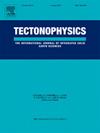Seismic imaging revealing the processes from subduction to arc-continental collision in the northeastern South China Sea
IF 2.7
3区 地球科学
Q2 GEOCHEMISTRY & GEOPHYSICS
引用次数: 0
Abstract
The northeastern margin of the South China Sea (SCS) is characterized by a tectonic shift from subduction in the south to arc-continent collision in the north. We describe the intraplate crustal-scale structure and deformation along a 256-km-long wide-angle reflection/refraction line perpendicular to the Manila Trench (MT). It is found that 1) the subducting plate of the northeast SCS comprises thinned continental crust with a thickness of 12–15 km and a high-velocity layer (HVL) with a thickness of 2–4 km, which is likely caused by (ultra)mafic intrusions; 2) the subducted upper crust is partly scraped off and accreted at the bottom of the accretionary wedge, and its characteristic low seismic-velocity may be due to subsequent hydration. Combined with previous investigations from six seismic lines in the study area across the MT and Southern Taiwan, from south to north, the velocity anomaly at the bottom of the accretionary wedge correspondingly undergoes a series of metamorphic processes in response to the transition from oceanic subduction to arc-continent collision.
揭示南海东北部从俯冲到弧陆碰撞过程的地震成像
南海东北缘以南俯冲向北弧陆碰撞为主的构造转变为主要特征。我们描述了垂直于马尼拉海沟(MT)的一条256公里长的广角反射/折射线上的板内地壳尺度结构和变形。研究发现:1)南海东北部俯冲板块由厚度为12 ~ 15 km的薄大陆地壳和厚度为2 ~ 4 km的高速层(HVL)组成,可能是由(超)基性侵入所致;2)俯冲的上地壳在增生楔底部部分被刮离和增生,其特有的低地震速度可能是由于后续的水化作用。结合研究区横贯MT和台湾南部的6条地震线的观测,从南到北,增生楔底部的速度异常相应地经历了一系列的变质过程,以响应从大洋俯冲到弧陆碰撞的转变。
本文章由计算机程序翻译,如有差异,请以英文原文为准。
求助全文
约1分钟内获得全文
求助全文
来源期刊

Tectonophysics
地学-地球化学与地球物理
CiteScore
4.90
自引率
6.90%
发文量
300
审稿时长
6 months
期刊介绍:
The prime focus of Tectonophysics will be high-impact original research and reviews in the fields of kinematics, structure, composition, and dynamics of the solid arth at all scales. Tectonophysics particularly encourages submission of papers based on the integration of a multitude of geophysical, geological, geochemical, geodynamic, and geotectonic methods
 求助内容:
求助内容: 应助结果提醒方式:
应助结果提醒方式:


